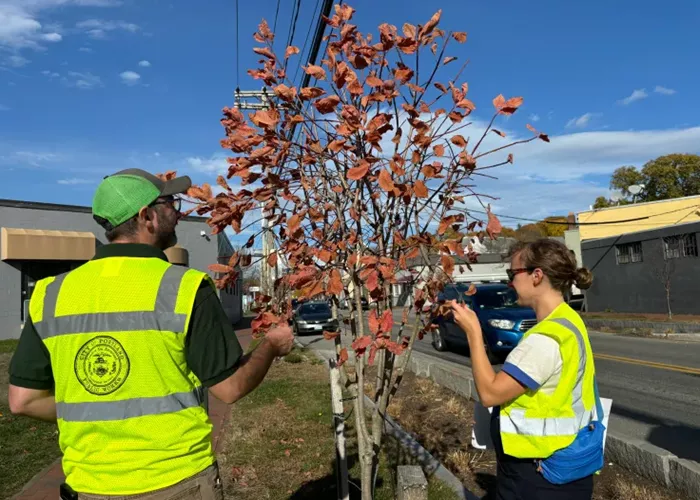On an unusually warm 74-degree day in November, standing in the sun felt almost too hot in Portland’s Bayside neighborhood. Tatyana Vashchenko, parks project manager for the city, asked, “Could we move to the shade?”
Vashchenko, along with the city’s Parks, Recreation, and Facilities Department, has been working to address this issue by planting more trees in Bayside. Earlier this month, the Bayside Tree Project completed the planting of 154 trees throughout the neighborhood.
Historically, Bayside has had fewer trees than other parts of Portland due to its industrial and commercial development, Vashchenko explained. While the city plants trees annually, a focused effort was necessary to increase the tree canopy in Bayside.
“This project was a chance to bring in a dedicated team to map and walk the area, giving us more capacity to plan tree planting throughout the neighborhood,” Vashchenko said. “We’re hopeful this approach could be used in other areas in the future as well.”
Bayside was identified as a priority area for tree planting by the American Forests Tree Equity Project, which highlights neighborhoods in U.S. cities with fewer trees. The initiative aims to improve environmental justice by identifying locations where tree planting would have the greatest impact.
Portland received an overall Tree Equity score of 87 out of 100, a score typical of cities in New England. However, when broken down by neighborhood, Bayside stands out with the lowest score in Portland—just 48. By comparison, the West End scores 99, and the Arts District scores 82. Bayside’s low score makes it a “highest priority” area for future tree projects.
The Tree Equity Project also considers factors like income, race, and age when identifying areas most in need of trees. In Bayside, 60% of residents live in poverty, 49% are people of color, and 23% are children or elderly. Due to the lack of tree cover and a high concentration of paved surfaces, the area can experience temperatures up to 18 degrees hotter than other neighborhoods during the summer.
Urban trees provide numerous benefits, including reducing heat, improving air quality, and intercepting stormwater. City Arborist Mark Reiland noted that these trees also contribute to community well-being. “While we may not see an immediate reduction in asthma rates, the overall health of the community improves,” he said. “Trees also have mental health benefits, helping reduce anxiety.”
The City Council allocated $250,000 from the American Rescue Plan Act in 2021 to support this initiative, bringing the total project cost to $275,000 when combined with a federal Community Development Block Grant. The funding covered mapping, analysis, and the purchase of trees and materials.
To determine where trees could be planted, the city hired the consulting firm Sebago Technics. The team identified locations throughout Bayside, including spots where contractors could carve out “tree wells” in paved surfaces to make room for the trees.
In a unique twist, the city purchased the trees and materials directly to reduce costs and attract contractors. Typically, contractors are responsible for caring for the trees for a year or two, but in this case, the city took on that responsibility.
Reiland handpicked all 154 trees from local nurseries, choosing species that are native to the region and resilient to challenges such as extreme heat, salt, and pests like the invasive emerald ash borer. With the borer expected to kill 500 of Portland’s 600 ash trees, diversifying tree species helps protect the city’s tree canopy from potential disasters.
A total of 27 species were planted, including familiar types like ginkgo, crabapple, and tulip poplar, as well as less common varieties like Carolina silverbell and American smoketree.
Residents have expressed strong enthusiasm for the new trees. Many have even started caring for them. One resident placed a small red birdhouse next to a newly planted hornbeam tree on Greenleaf Street. “It’s been really positive,” Vashchenko said, noting the sense of community ownership. “People seem genuinely excited and invested in the project.”
As the trees continue to grow, the hope is that Bayside will see a significant improvement in its environmental and social conditions, benefiting residents for years to come.
Related topics:
- Police Seize Over 8,000 Cannabis Plants in Fairfield Raids, Shut Down 8 Grow Houses
- Steve Erdman: Why Plants Depend on Carbon Dioxide to Thrive
- Gardener Reveals the Perfect Flower to Plant for a Vibrant Red and Pink Display


